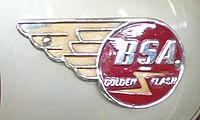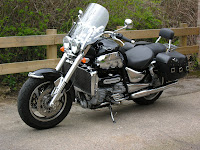BSA Golden Flash
BSA Golden Flash
 | |
| Manufacturer | |
|---|---|
| Also called | A10 |
| Production | 1950-61 |
| Predecessor | BSA A7 |
| Successor | BSA Super Rocket |
| Engine | 646cc air cooled twin |
| Power | 35 bhp @ 4500 rpm |
| Transmission | four speed gearbox to chain drive |
| Wheelbase | 54.75 inches (139.1 cm) |
| Dimensions | L 84 inches (210 cm) |
| Fuel capacity | 3.5 gallons |
Its development after the 1937 launch of the ground breaking Triumph Speed Twin, together with the need to pay off British war-debt, led to the two creating the post-war rise of the parallel twin engine layout, which was to dominate British design throughout the 1950s and 60s.
Background
Bert Hopwood had left school to serve an apprenticeship under designer Val Page at Ariel. In 1936, Hopwood moved to Triumph, where he worked under Edward Turner to develop the ground breaking Triumph Speed Twin. Post World War 2, Hopwood accepted an offer in April 1947 from Norton, where he designed the Norton Dominator engine.The movement of Hopwood around the three manufacturers meant that all three were ahead of BSA in manufacturing a modern parallel-twin. The then largest and most financially stable manufacturer needed to compete, and although it had launched a pre-war designed parallel-twin in the form of the BSA A7, it was possibly fateful that Hopwood feel out with Norton, and left the company 12months after joining them.
Development
In May 1948, Hopwood joined BSA.Briefed specifically to create a competitive parallel-twin, the internally designated A10 model was based on an earlier A7 design by Page and Bert Perkins. After BSA took over Triumph in 1951, Hopwood returned to Norton. |
| Early Golden Flash A10s had frames with either no rear suspension, or "plungers", and had a semi-unit engine and gearbox, with the gearbox bolted to the rear of the engine |
Launched in October 1949, the A10 Golden Flash was a new post-war design, with most of the difference to the A7 being in the engine. Increased to 650cc, it encompassed revised castings for the cylinder head and rocker box, and a cast-in carburettor manifold. The frame was available in rear rigid format, but the more common option was the then new plunger suspension, specifically designed for overseas export. BSA was a manufacturer who focused on machines for the working man, and so the design incorporated two practical use features: a hinged rear mudguard, designed to ease rear wheel removal; and a semi-unit engine and gearbox arrangement. The semi-unit power train enabled the primary chain to be adjusted via a slipper within the primary chain case.
Production
 |
| Early cast Golden Flash tank badge |
Although never designed as a fast machine, the Golden Flash was none the less fast machine for its time and competitive with the Triumph Tiger 100, achieving over 100 miles per hour (160 km/h) in tests in 1950, and covering a standing quarter mile in under 16 seconds. Its gold colour also made it a marketing and sales success, out selling the red Speed Twin and the later blue-grey Triumph 6T Thunderbird, which was resultantly revised the following year into polychromatic blue.
However, BSA were concerned about a tendency for wear in the rear, plunger suspension, leading to uncertain handling. In 1954 it revised the model with a modern swinging arm, and the hinged mudguard was deleted. The semi-unit power train was also abandoned, making for a more involved procedure for adjustment of the primary chain, it offered benefits in the areas of the clutch and gearbox internals. The revisions also allowed for the launch of more sporting A10 Road Rocket.
In 1956, alloy brake drums were fitted as standard which both reduced unsprung weight and increased stopping power.
In 1957, the 40bhp 105 miles per hour (169 km/h) BSA Super Rocket was launched for the 1958 season, with an Amal TT carburettor and high lift cam.
The final A10 development, and fastest in terms of power and performance, the 1962 BSA Rocket Gold Star, which fitted a tuned A10 Super Rocket engine into the well proven BSA Gold Star single frame. The result was a good handling fast bike that was a true classic. Current demand for the Rocket Gold Star, or "RGS", is such that non-RGS A10s are sometimes sold as originals, having been modified using suitable alternative parts.
With the launch of the new unit-construction (combined engine/gearbox) BSA A50 and BSA A65, the A7 and A10 were discontinued at the end of 1962 but the Rocket Gold Star continued into 1963 production.



